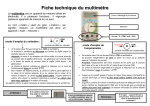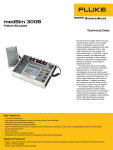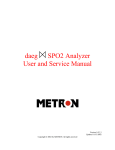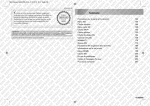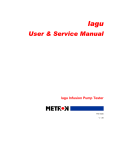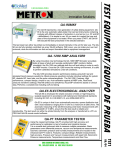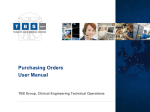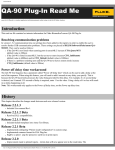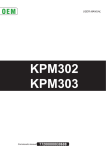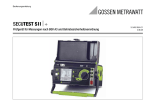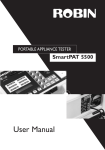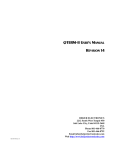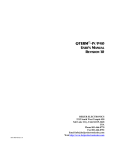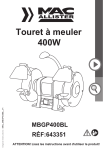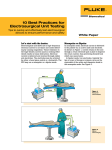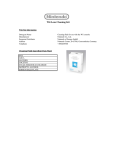Download 10 - Fluke
Transcript
QA-90 User Manual QA-90 Electrical Safety Analyzer P/N 11025 V.3.47-3 Copyright 2004 by METRON. All rights reserved. METRON: USA _ ____ 1345 Monroe NW Grand Rapids, MI 49505 Phone: (+1) 888 863-8766 Fax: (+1) 616 454-3350 E-mail: [email protected] FRANCE________ 30, rue Paul Claudel 91000 Evry, France Phone: (+33) 1 6078 8899 Fax: (+33) 1 6078 6839 E-mail: [email protected] GERMANY Gundastrasse 29 D-63762 Grossostheim Phone: (+49) 6026 993975 Fax: (+49) 6026 977079 E-mail:[email protected] NORWAY______ Vegamot 8 N-7048 Trondheim Phone: (+47) 7395 4700 Fax: (+47) 7395 4701 E-mail: [email protected] Disclaimer METRON provides this publication as is without warranty of any kind, either express or implied, including but not limited to the implied warranties of merchantability or fitness for any particular purpose. Further, METRON reserves the right to revise this publication and to make changes from time to time to the content hereof, without obligation to METRON or its local representatives to notify any person of such revision or changes. Some jurisdictions do not allow disclaimers of expressed or implied warranties in certain transactions; therefore, this statement may not apply to you. Limited Warranty METRON warrants that the QA-90 Electrical Safety Analyzer will substantially conform to published specifications and to the documentation, provided that it is used for the purpose for which it was designed. METRON will, for a period of twelve (12) months from date of purchase, replace or repair any defective analyzer, if the fault is due to a manufacturing defect. In no event will METRON or its local representatives be liable for direct, indirect, special, incidental, or consequential damages arising out of the use of or inability to use the QA-90 Electrical Safety Analyzer, even if advised of the possibility of such damages. METRON or its local representatives are not responsible for any costs, loss of profits, loss of data, or claims by third parties due to use of, or inability to use the QA-90 Electrical Safety Analyzer. Neither METRON nor its local representatives will accept, nor be bound by any other form of guarantee concerning the QA-90 Electrical Safety Analyzer other than this guarantee. Some jurisdictions do not allow disclaimers of expressed or implied warranties in certain transactions; therefore, this statement may not apply to you. ii Table of Contents MANUAL REVISION RECORD ......................................................................................................... V 1. INTRODUCTION ................................................................................................................... 1-1 1.1 1.2 1.3 2. INSTALLATION ..................................................................................................................... 2-1 2.1 2.2 2.3 2.4 3. Receipt, Inspection and Return ...........................................................................................2-1 Setup ...................................................................................................................................2-2 Power ..................................................................................................................................2-2 Ansur & PRO-Soft ..............................................................................................................2-2 OPERATING QA-90 ............................................................................................................... 3-1 3.1 3.2 3.3 3.4 3.5 3.6 3.7 3.8 3.9 4. QA-90 Features ...................................................................................................................1-1 Specifications ......................................................................................................................1-1 General Information ............................................................................................................1-3 Control Switches and Connections .....................................................................................3-1 Key Pad Functions ..............................................................................................................3-3 Function of The Bar Code Reader ......................................................................................3-3 Menu and Function Keys ....................................................................................................3-4 Display Menus and Messages .............................................................................................3-4 Measurements with Several Modules in Manual Mode ......................................................3-9 Storing Setup Parameters in Flash Memory ......................................................................3-10 Upgrading the QA-90 Software Program..........................................................................3-11 Cleaning the QA-90 ..........................................................................................................3-14 EXAMPLE TEST MEASUREMENTS ................................................................................. 4-1 4.1 4.2 4.3 4.4 4.5 4.6 4.7 4.8 Test Lead Calibration..........................................................................................................4-1 Connecting an Instrument without Patient Inputs ...............................................................4-2 Connecting an Instrument with Patient Inputs ....................................................................4-3 Power Cable Test ................................................................................................................4-5 Current Measurement Test (Dual Lead)..............................................................................4-6 Voltage Measurement Test (Dual Lead) .............................................................................4-8 Resistance Measurement (Dual Lead)...............................................................................4-10 Connecting Auxiliary Power Source / Isolating Transformer ...........................................4-11 APPENDIX A: IEC 60601.1, UL 2601.1 AND VDE 0751 TESTING ................................................ 1 A.1 A.2 A.3 A.4 A.5 Classification of Equipment ................................................................................................... 1 Tests on Mains Powered Class 1 & 2 Equipment According To IEC 60601.1/UL 2601.1 ... 4 Tests on Internally Powered Equipment According To IEC 60601.1/UL 2601.1 ............... 13 System Tests Based on IEC 60601.1/UL 2601.1 ................................................................. 15 Tests According To VDE 0751:10-1990/2001 .................................................................... 16 iii APPENDIX B: ERROR REPORT FORM, QA-90 ............................................................................. 1 APPENDIX C: SUGGESTION FORM, QA-90 ................................................................................... 1 iv Manual Revision Record This record page is for recording revisions to your QA-90 User and Service Manual that have been published by METRON or its authorized representatives. We recommend that only the management or facility representative authorized to process changes and revisions to publications: make the pen changes or insert the revised pages; ensure that obsolete pages are withdrawn and either disposed of immediately, or marked as superseded and placed in a superseded document file, and; enter the information below reflecting that the revisions have been entered. Rev No 0 Date Entered - Reason Signature of Person Entering Change Initial Release 3.13-1 04-26-01 General update 3.47-1 01-15-04 General update 3.47-2 07-27-06 Change of Spec. Voltage Measurement. BW = 1 kHz Hans Ove Kristiansen/FBE 3.47-3 2007.01.22 Removed service information GeS v Symbols Used In This Manual Caution (Refer to accompanying documents) (See NOTE) Caution, Risk of Electrical Shock (see NOTE) Earth (ground) TERMINAL vi 1. Introduction This chapter describes the QA-90 Electrical Safety Tester’s features and specifications. 1.1 QA-90 Features The QA-90 represents a new generation of safety testing equipment. It is the only automatic safety analyzer that can test units with different classes of protection in one test run (e.g., cardiac float and body float defibrillators). It is simple to use. All you need do is select the type and class of equipment to test. When you press START, QA-90 executes the tests prescribed to the selected standard. Test results may be printed out immediately, or stored internally in the unit for later use. QA-90 has full remote control, and may be operated from PRO-Soft QA-90 software. PRO-Soft QA-90 enables you to make your own test protocols, store the information on disk, and export formatted data to any other database or equipment management program. Individual test sequences may be compiled to satisfy national and international standards. The following standards may be compiled either fully or in part: IEC 60601.1, UL 2601.1, IEC 60601.1.1, UL 2601.1.1, IEC 60601.2.4, IEC 61010-1, EN 60601-1, VDE 0750 Tl/12-91, BS 5724, CAN/CSA-C22.2 No 601.1-M90, AS 3200.1, NZS 6150:1990, VDE 0751-1:10-1990, VDE 0751-1:10-2001, ÖVE 0751, UL 544, HEI 95, HEI 158 among others. 1.2 Specifications 1. Voltage Measurement Measurements may be obtained in the following ways: Between leads 1 and 2 (in the power contact). Between lead 1 and ground (in the power contact). Between lead 2 and ground (in the power contact). Between input/output E+ and E- (floating inputs/outputs). Range Resolution Accuracy No. of Tests 0 - 400V true RMS. 0.1V DC - 100 Hz, 1% of full scale +1 LSD 100 Hz-1 kHz, 2% of scale +1 LSD 4 or multiple (LSD = least significant digit) 1-1 2. Current Consumption The current measurement may be executed in lead no. 1 (live). Range 1 Resolution Accuracy No. of Tests 0 - 1000 mA RMS (@ <250VAC) 1 mA 2% of full scale 1 LSD 1 or multiple Range 2 Resolution Accuracy No. of Tests 1 - 16A RMS (@ <250VAC) 1 mA 1% of full scale 1 LSD 1 or multiple 3. Protective Earth The test current is selectable from 25A or 1A, delivered from a transformer with a maximum idle voltage of 6V. The measurement can be performed on ground leads or between E+ and E- (floating inputs/outputs). Range Resolution Accuracy No. of Tests 0 - 2000 mOhm 1 mOhm 2% of full scale 1 LSD 1, 2, or multiple 4. Insulating Resistance The measurement of the insulating resistance may be executed between casing and power unit, or between patient module and power unit. Test voltage: No. of Tests: 500VDC through a 130 kOhm limiting resistor. 1, 2 or multiple Range Resolution Accuracy 1 - 50 mOhm 1 mOhm 2% of full scale 1 LSD Range Resolution Accuracy 51 - 200 mOhm 1 mOhm 2% of full scale 1 LSD 5. Leakage Currents All measurements can be performed with a IEC 601.1 filter (patient equivalent), or without (flat frequency response). The filter can be exchanged with filters covering other standards. All measurements can be performed as true RMS measurements, or AC/DC measurements. The following leakage currents can be measured: Ground leakage current Enclosure leakage current Differential current * Substitute equipment lekage current Direct leakage current Leakage current fig. 9 1-2 No. of Tests: 4 No. of Tests: 6 or multiple No. of Tests: 2 No. of Tests: 1 No. of Tests: 2 No. of Tests: 1 The following leakage currents are measured for each module: Patient leakage current Mains on applied part leakage current Patient Auxiliary current Substitute patient leakage current Floating dual lead measurement of leakage currents No. of Tests: 6 No. of Tests: 2 No. of Tests: 6 No. of Tests: 1 No. of Tests: Multiple In one test run a maximum of 11 modules with different protection classes may be tested. 6. Accuracy Range 1 Resolution Accuracy 0- 100 µA 1 µA 2% of full scale 1 LSD Range 2 Resolution Accuracy 100- 1000 µA 1 µA 2% of full scale 1 LSD Range 3 Resolution Accuracy 1,0 - 10,0 mA 1 µA 1% of full scale 1 LSD 7. Frequency Response DC - 1 MHz (-3dB) with a crest factor of >2 The applied test voltage for patient leakage current is 110% of the line voltage, delivered through a limiting resistor of 47 kOhm. 1.3 General Information Temperature Requirements +15 C to +35 C when operating 0 C to +50 C in storage Display Type Alphanumeric format LCD graphic display 4 lines, 40 characters Data Input/ Output (2) Parallel printer port (1); Bi-directional RS -232C (1) for computer control Power From 110 VAC to 240 VAC, 47/ 63 Hz 3900 VA Do not exceed 16 Amps of current at any voltage within the operating range. Installation Category II Fuses Two 16 Amp, 250V slow blow fuses 1-3 Mechanical Specifications Housing Height Width Depth Weight Metal case 13.2 cm 34.2 cm 30.5 cm 5.8 kg 3.9 in. 9.8 in. 11.0 in. 4.1 lbs. Standard Accessories User and Service Manual QA-90 (P/N 11025) Additional Accessories Carrying Case Carrying case, ext. printer Bar Code Reader Isolating transformer 400VA Isolating transformer 800VA Test unit (ESA) E input measuring cable (2m) E input measuring cable (5m) Clamp - crocodile type PRO-Soft QA-90 software PRO-Soft QA-90 DEMO User/Service Manual PRO-Soft QA-90 (P/N (P/N (P/N (P/N (P/N (P/N (P/N (P/N (P/N (P/N (P/N (P/N 11100) 10500) 11400) 11401) 11410) 11402) 11411) 11415) 11412) 11200) 11201) 11225) Storage Store in the carrying case in dry surroundings within the temperature range specified. There are no other storage requirements. Periodic Inspection The unit should be calibrated every 12 months. 1-4 2. Installation This chapter explains unpacking, receipt inspection and claims, and the general procedures for initial QA-90 setup. Example test setup procedures are contained in Chapter 4, Example Test Measurements. 2.1 Receipt, Inspection and Return 1. Inspect the outer box for damage. 2. Carefully unpack all items from the box and check to see that you have the following items: QA-90 Electrical Safety Tester (P.N. 11200) QA-90 User and Service Manual (P.N. 11025) 3. If you note physical damage, or if the unit fails to function according to specification, inform the supplier immediately. When METRON AS or the company’s representative, is informed, measures will be taken to either repair the unit or dispatch a replacement. The customer will not have to wait for a claim to be investigated by the supplier. The customer should place a new purchase order to ensure delivery. 4. When returning an instrument to METRON AS, or the company representative, fill out the address label, describe what is wrong with the instrument, and provide the model and serial numbers. If possible, use the original packaging material for return shipping. Otherwise, repack the unit using: a reinforced cardboard box, strong enough to carry the weight of the unit. at least 5 cm of shock-absorbing material around the unit. nonabrasive dust-free material for the other parts. Repack the unit in a manner to ensure that it cannot shift in the box during shipment. METRON’s product warranty is on page ii of this manual. The warranty does not cover freight charges. C.O.D. will not be accepted without authorization from METRON A.S or its representative. 2-1 2.2 Setup 1. Equipment connection is as shown in the typical setup below. Attach the printer cable to the 25-pin outlet port. 2. If ansur or PRO-Soft is being used, attach an RS-232C (null modem/data transfer configured) cable to the 9-pin D-sub outlet port located at the rear of the QA-90. Do not attach the printer cable to the QA-90. See below. NOTE Some RS-232C cables are missing the connection between the seventh and the eighth wires in the cable. The cable may still be called NULL-modem, but it will not work with the QA-90. Refer to the ansur or PRO-Soft QA-90 Users Manual for more information. 2.3 Power Main On/Off Switch. QA-90 should remain off for at least 5 seconds before switching on again, in order to allow the test circuits to discharge fully. 2.4 Ansur & PRO-Soft Ansur and PRO-Soft are front-end test automation and presentation tools for METRON's QA-90 Electrical Safety Analyzer. It allows you to conduct the same tests, but by remote control via an computer run- 2-2 ning Windows 98, 2000 or XP. Additionally, the program has additional features to automate and enhance your electrical safety testing. Each of the QA-90 tests can be run independently from ansur or PROSoft in the “Manual” test mode. Results are shown on the PC screen during testing, and the user is prompted to set the tested equipment accordingly. At the conclusion of tests, the user may print a report, store the test and results on disk, or both. Combinations of tests can be created and stored as “Test Template.” The program maintains a library of these templates. In this way you can store and retrieve templates that are appropriate for each kind of equipment being tested at your facility. NOTE Ansur and PRO-Soft has its own user manual, which contains all the information concerning the program. If you order a demonstration version of the program you also receive the manual. Templates can include checklists, written procedure, and equipment data in the form of a test “Protocol.” The equipment data can be entered manually into the protocol, or it may be retrieved by ansur or PRO-Soft from a database program or other equipment files. Protocols can be created easily for each item of equipment in your inventory, and stored for use. Test protocols with results can be printed, or stored on disk, and the results of testing can be sent back to the equipment database to close a work order and update the service history. 2-3 This page intentionally left blank. 2-4 3. Operating QA-90 This chapter explains the operating controls, switches and menus of the QA-90, details how to use them in testing, and provides general information on printouts and operator maintenance. 3.1 Control Switches and Connections Front Panel Max 265 VAC Max 500 VDC 1. Key Pad 11 alphanumeric keys, used to enter information. Patient Leads: New window for recording patient inputs. Clear: Clears the whole display Return: Deletes the last character Enter: Records entered data 2. Function Keys F1-F4 are used to select the functions shown in the menu bar at the bottom of the display, i.e., for selecting the function that is directly above the key. F5-F7 are used to select the function, or enter information in the message field in the same line. 3 LCD Display Shows messages, test results and function menus. 3-1 4 Patient Leads For connecting patient inputs. Caution: Max 256 VAC Max 500 VDC can be present during specified tests 5. Dual E+ and E-, floating inputs/outputs. These function in the manner of standard multimeter leads. 6. Encl. Enclosure (for connecting to the casing of the instrument under test). 7. Earth Extra earth connection for calibrating measuring leads. 8. Contact For connecting the power plug of the instrument to be tested. Rear Panel Power Switch Turns power ON and OFF. 10. RS-232 Serial Port 9-pin D-sub 11. Bar Code Port 9-pin D-sub. HP-Smartwand Interface (TTL). 12. Printer Outlet Port 25 pin D-sub. Centronic output. 13. Mains QA-90 Mains connection for test instrument. 14. Auxiliary Power Auxiliary power connection for instrument under test. 15. Fuse Mains fuses 2 x 16 Amps @ 220V 16. Earthing Contact Extra earthing point. 9. 3-2 3.2 Key Pad Functions The alphanumeric keys comprise both numbers and letters. Hold the key in and it moves automatically from character to character. 3.3 Function of The Bar Code Reader The bar code reader may be used in the main menu and in the patient lead to record respectively the instrument code and class, module code, number of leads and type. The program will select the correct screen display, depending on the bar code format. The program will give a beep if a wrong format is read. INSTRUMENT CODE FORMAT FIELD DESC. VALUE ACCEPTED MAX. CHARACTERS Instrument code alphanumeric 20 Separator + 1 (must be included) Instrument class CLI, CL2, I.P 3 (must be included) Example: abcdefg + CL2 Instrument code = abcdefg Instrument class = CL2 PATIENT LEAD FORMAT FIELD DESC. VALUE ACCEPTED MAX. CHARACTERS Module code alphanumeric 20 Separator + 1 (must be included) No. of leads numeric (0-99) 2 Separator + 1 (must be included) Type BF, CF, B 2 (must be included) Example: mnopqrst + 2 + B Module code = mnopqrst Number of leads = 2 Module type = B 3-3 3.4 Menu and Function Keys The QA-90 uses displays, function keys and a keypad to provide flexibility and control over operations. The top three lines in the display are used for messages, status and results. The menu bar is shown at the bottom of the display. Function keys are numbered from F1 to F7. A function/menu is selected by pressing that key which is directly below/to the right of the menu unit shown in the display. 3.5 Display Menus and Messages 1. Startup Screen. The following screens will be displayed in sequence for the first 10 seconds after the QA-90 has been switched on. METRON QA-90 F7 F6 Boot software F1 F2 version: X.XX F3 F5 F4 METRON QA-90 F7 F6 Version: X.XX F1 F2 Date: DD/MM/YYYY F3 F5 F4 METRON QA-90 Electrical Safety Analyzer TOTAL MEMORY : 114688 TOTAL MEMORY USED : 6884 TOTAL FREE SPACE : 107804 F1 3-4 F2 F3 F4 F7 F6 F5 2. Main Menu Equipment Code : ...> Sequence Name : ...> Class: CL1 ,0 leads in 0 modules.......> MORE MEMORY SETUP START F1 F2 F3 F7 F6 F5 F4 3. MORE (F1). When MORE (F1) is pressed, the following display will appear: Test according to Test Type Test Mode GO BACK F1 F2 : IEC60601.1 ......> : Rapid ...........> : Automatic .......> START F3 F7 F6 F5 F4 This window offers the following functions: Press Test according to (F7) to select either IEC 60601.1, IEC 60601.2.4, IEC 61010-1, UL 2601.1, IEC61010, AS 3200.1, HEI 95, DB 9801, ANSI/AAMI, VDE 0751:101990 or VDE 0751:10-2001 Standards. Press Test Type (F6) to select either Rapid or Normal test type. Press Test Mode (F5) to choose between Automatic and Manual test. Press GO BACK (F2) to return to the previous display. Press START (F4) to start the test. 4. MEMORY (F2) QA-90’s memory is divided into two parts: tests and sequences. If you have several equivalent instruments to test, you can define one test sequence for all the instruments and store it as a sequence. You use this sequence to test all the instruments and store each of the test results with the instrument’s respective equipment code. The functions in the MEMORY menus enable you to store, retrieve, transfer, print and delete test results and sequences from the memory. The four main memory displays are as follows. 3-5 Equipment Code : ...> Store test in memory ..................> Display test results ..................> MORE SEQ.MEM TEST MAIN MENU F1 F2 F3 F2 F3 F2 F3 F2 F3 F6 F5 F7 F6 F5 F4 Equipment Code : ...> Delete test in memory .................> Delete all tests in memory ............> MORE GO BACK MAIN MENU F1 F7 F4 Transfer all tests from memory ........> List test in memory to printer ........> Print all tests in memory .............> MORE GO BACK MAIN MENU F1 F6 F5 F4 Equipment Code : ...> Recall and transfer test from memory ..> Recall and print test from memory .....> MORE GO BACK MAIN MENU F1 F7 F7 F6 F5 F4 The F5 and F6 function keys generate new displays as confirmation of an executed function or error message. Press GO BACK (F2) to return to the previous display. Press MAIN MENU (F4) to start the test. The three main sequence displays are shown below. Sequence name : ...> Store seq. in memory ..................> Print sequence ........................> MORE GO BACK SEQ MAIN MENU F1 3-6 F2 F3 F4 F7 F6 F5 List all sequences in memory ..........> Print all sequences in memory .........> F7 F6 F5 MORE GO BACK F1 MAIN MENU F2 F3 F4 Sequence name : ...> Delete sequence in memory .............> Delete all sequences in memory ........> GO BACK MAIN MENU F1 F2 F3 F7 F6 F5 F4 5. SETUP (F3) This function is used for entering general information in connection with the test. Seven main displays are shown below. SYSTEM SETUP Operator : Establishment : MORE STORE CAL. F1 F2 QA-90 Serial no IT-Net Power-up delay time MORE GO BACK F1 F2 QA-90 Serial no IT-Net Power-up delay time MORE GO BACK F1 F2 F7 ...> ...> MAIN MENU F3 F4 : XXXXX .> : N ..........> : 2 Seconds.> CAL. MAIN MENU F3 F7 F6 F5 F4 : XXXXX .> : N ..........> : 2 Seconds.> CAL. MAIN MENU F3 F6 F5 F7 F6 F5 F4 3-7 Stop at new power config : Stop before new power config : Stop at new module : MORE GO BACK CAL. MAIN F1 F2 F3 Multiple Protective Earth Tests : Multiple Enclosure Tests : PE Test Current : MORE GO BACK CAL. MAIN F1 F2 F2 N ...> N ...> 25 A.> MENU N ...> Y ...> N ...> MENU F3 F2 F6 F5 F7 F6 F5 F4 F3 F7 F6 F5 F4 Language : English ....................> Date : XX/XX/XXXX (DD/MM/YYYY) ...> Time : XX:XX:XX (HH:MM:SS) .....> MORE GO BACK AM/PM MAIN MENU F1 F7 F4 F3 External Isolating Transformer : Acoustic alarm for failed test : Auxiliary Power : MORE GO BACK CAL. MAIN F1 N ...> N ...> N ...> MENU F7 F6 F5 F4 Report page length(no of lines) :58 ...> F7 FIRMWARE Ver. XX.XX GO BACK F5 F6 F1 F2 CAL. MAIN MENU F3 F4 6. Recording and Storing Patient Modules and Patient Leads. Press PL on the keypad to obtain the window for recording patient modules and leads. Module Code : .....> No of leads : .......................> Type : CF.......................> ADD GO BACK PREV. NEXT 3-8 F7 F6 F5 F1 F2 F3 F4 Go to the next patient module stored Go to the previous patient module stored. Return to the previous menu Press ADD (F1) to save in the memory Press Module Code (F7) to record the code/name of a new patient module. Press ENTER ( ). Press No of leads (F6) to enter the number of patient leads. Press ENTER ( ). Press Type (F5) to select protective class (B, BF, CF). Press ADD (F1) to save in the memory. The number of modules stored will be shown in parenthesis in the Module Code line. Repeat the above guidelines to enter the next module. Press NEXT (F4) to go to the next patient module stored. Press PREV (F3) to go to the previous patient module stored. Press GO BACK (F2) to return to the previous menu. 7. START (F4). This function starts the test sequence. Manual or automatic test sequences are selected under MORE (F1) in MAIN MENU. 3.6 Measurements with Several Modules in Manual Mode When you perform measurements on several modules in Manual Mode and want to select which module to measure, use the following procedure: 1. Press MORE (F1) in MAIN MENU. Equipment Code : ...> Sequence Name : ...> Class: CL1 ,0 leads in 0 modules.......> MORE MEMORY SETUP START F7 F6 F5 3-9 F1 2. F2 F4 Press Test Mode (F5) and select Manual. Press START (F4). Test according to Test Type Test Mode GO BACK F1 3. F3 : IEC60601.1 ......> : Rapid ...........> : Manual ..........> START F2 F3 Press MORE (F1) in repeatedly until you find the desired measurement, e.g., Mains on applied part (F5). F1 F2 F3 F7 F6 F5 F4 Press PL on the keypad to obtain the recording window for Module Code and No of leads. Module Code : .....> No of leads : .......................> Type : CF.......................> ADD GO BACK PREV. NEXT F1 F2 F3 F7 F6 F5 F4 5. Select which Module Code to be measured with NEXT (F4) or Prev. (F3). 6. Press GO BACK (F2). 7. Press START (F1) to start the test. 8. Press STOP (F1) to stop the test. 9. To select a new module, press PL and repeat the same procedure. 3.7 Storing Setup Parameters in Flash Memory The following parameters can be stored in Flash memory: Operator 3-10 F6 F5 F4 MANUAL TEST SETUP Mains Voltage .........................> Current Consumption ...................> MORE MAIN MENU 4. F7 Establishment Serial Number Language Calibration parameters To store the setup parameters in Flash memory, go to SETUP (F3) in MAIN MENU. Equipment Code : ...> Sequence Name : ...> Class: CL1 ,0 leads in 0 modules.......> MORE MEMORY SETUP START F1 F2 F3 F7 F6 F5 F4 Press STORE (F2) in SYSTEM SETUP and the display will show you the setup parameters stored in flash. SYSTEM SETUP Operator : Establishment : MORE STORE CAL. F1 F2 F7 ...> ...> MAIN MENU F3 F6 F5 F4 3.8 Upgrading the QA-90 Software Program For installing software, version 2.00 or higher, use the following procedure: 1. Preparation IMPORTANT! When upgrading the software on calibrated units, you should note the calibration constants in the unit. There are seven constants that can be read on the unit display. Turn on the unit. Press SETUP (F3) from the Main menu. Equipment Code : ...> Sequence Name : ...> Class: CL1 ,0 leads in 0 modules.......> MORE MEMORY SETUP START F1 F2 F3 F7 F6 F5 F4 3-11 Press CAL (F3) from the System Setup. SYSTEM SETUP Operator : Establishment : MORE STORE CAL. F1 F2 F7 ...> ...> MAIN MENU F3 F6 F5 F4 Then go to the hidden menu under (F1), in the menu for Self Calibration. SELF CALIBRATION Calibrate test lead, enclosure/earth ..> Calibrate test lead, dual float .......> GO BACK MAIN MENU F1 F2 F3 F7 F6 F5 F4 Note the values on the three constants that appear on the display. Press MORE (F1) to get the three next constants. Press MORE (F1) to get the last constant. NB: Automatic MAP calibration: ONLY for production calibration. The QA-90 software upgrade contains two files: comqa90.exe, the communication between computer and the QA-90, and; qa90-xxx.a07 is the program for QA-90. (XXX indicates the version of the firmware.) 2. Prepare the QA-90 for the software upgrade. Reading the program to Flash memory in the QA-90. Press and hold PL and CLR at the same time while turning the QA-90 on. The display will show the following: The software in the QA-90 is missing. To download new software, run COMMQA90 on the PC and press ENTER on QA-90 3-12 The QA-90 is ready to receive data. 3. Prepare the PC for the upgrade. Connect an RS-232 cable between PC and QA-90. Insert the disk that contains the QA-90 upgrade program. Write COMMQA90.EXE (DOS) Press ENTER ( ) A menu will appear on the computer: Choose menu 1 SET PARAMETERS and choose new parameters or default values. Choose menu 2 START COMMUNICATION by pressing 2. Enter filename QA90-XXX.A07 where XXX is the version of the firmware. Check the file. Press ENTER ( ) on the computer. Press ENTER ( ) on the QA-90 and the transmission will start. If the communication is successful, >>>>>>> will appear continuously at the display on the QA-90. When the program is transmitted, a normal startup menu will appear on the QA-90. The computer will either show a picture for program transmission, or a clear screen. 4. Check the Calibration Constants Check the calibration constants in the QA-90 through the hidden menu. If necessary, press F5, F6 or F7 to type your noted calibration constants, then press ENTER ( ). To store in Flash memory, go back to SYSTEM SETUP. SYSTEM SETUP Operator : Establishment : MORE STORE CAL. F1 F2 F7 ...> ...> MAIN MENU F3 F6 F5 F4 Press STORE (F2) and the display will show you setup parameters stored in flash. 3-13 3.9 Cleaning the QA-90 The outside of the instrument may be cleaned using a damp cloth and mild detergent. Please note that solvents like Methanol may dammage the overlay and cabinet. 3-14 This page intentionally left blank. 3-15 4. Example Test Measurements This chapter contains test examples for the QA-90, illustrating equipment connections for the tests, as well as step-by-step procedures for obtaining desired test measurements. For more information on safety testing, and an explanation of protective classes, refer to Appendix A, IEC 60601.1, UL 2601.1 and VDE 0751 Testing. 4.1 Test Lead Calibration The self-calibration function of the QA-90 is used to determine test lead resistance, and for the values to be taken into account during subsequent testing. 1. Prior to performing self-calibration connect a test lead between the enclosure and earth connectors, or the dual lead inputs on the front face of the QA-90 (see below). Disconnect all other leads. 2. Press SETUP (F3) in MAIN MENU. 3. Press CAL (F3) in SYSTEM SETUP. 4. In the SELF CALIBRATION window select an option by pressing either Calibrate test lead, enclosure/ground (F6) or Calibrate test lead, dual float (F5). Equipment Code : ...> Sequence Name : ...> Class: CL1 ,0 leads in 0 modules.......> MORE MEMORY SETUP START F1 F2 F3 F7 F6 F5 F4 4-1 SYSTEM SETUP Operator : Establishment : MORE STORE CAL. F1 F7 ...> ...> MAIN MENU F2 F3 F4 SELF CALIBRATION Calibrate test lead, enclosure/earth ..> Calibrate test lead, dual float .......> GO BACK MAIN MENU F1 5. F2 F6 F5 F3 F7 F6 F5 F4 The test result for the calibration appears in the display when the test is complete. Test lead enclosure/grnd Test lead, dual float : : XXX mOhm XXX mOhm F7 F6 F5 GO BACK F1 F2 PRINT MAIN MENU F3 F4 4.2 Connecting an Instrument without Patient Inputs NOTES Ensure that the mains switch on the instrument to be tested is switched ON. Connect the mains plug of the instrument to be tested to the QA-90’s terminal on the front panel. Then, connect a calibrated test lead between the ENCL connector on the front panel of the QA-90 and the casing of the instrument to be tested. (See below) If the message REVERSED POLARITY is shown in the MAIN MENU, reverse the mains plug. 1. 4-2 Press Equipment Classification (F6) and select classification. 2. Press MORE (F1). 3. Press Test according to (F7) and select test standard. 4. Press Test Type (F6) and select either Rapid or Normal. 5. Press Test Mode (F5) and select either Automatic or manual. 6. Press START (F4) to start the test. Equipment Code : ...> Sequence Name : ...> Class: CL1 ,0 leads in 0 modules.......> MORE MEMORY SETUP START F1 F2 Test according to Test Type Test Mode GO BACK F1 F2 F3 F6 F5 F4 : IEC60601.1 ......> : Rapid ...........> : Automatic .......> START F3 F7 F7 F6 F5 F4 4.3 Connecting an Instrument with Patient Inputs This includes IEC Classifications Body (B), Body Float (BF), and Cardiac Float (CF). NOTE Ensure that the mains switch on the instrument to be tested is switched ON. Connect the mains plug of the instrument to be tested to the QA-90’s terminal on the front panel. Then, connect a calibrated test lead between the ENCL connector on the front panel of the QA-90 and the casing of the instrument to be tested. Following that, connect patient lead between the instrument to be tested and Patient leads on the QA90. (See below) 4-3 1. Press Equipment Classification (F6) and select classification. 2. Press MORE (F1). 3. Press Test according to (F7) and select test standard. 4. Press Test Type (F6) and select either Rapid or Normal. 5. Press Test Mode (F5) and select either Automatic or Manual. 6. Press PL on the keypad to obtain the recording window for patient lead. 7. Press Module Code (F7) if you wish to record the name of a new module. 8. Press ENTER (. ). 9. Press No of leads (F6) to enter the number of leads. 10. Press ENTER (. ). 11. Press Type (F5) to select protective class. 12. Press ADD (F1) to accept. The number of modules stored will be shown in parenthesis in the Module Code line. 13. Repeat, as required, to enter a new patient module. 14. Press GO BACK (F2) to return to the menu. 15. Press START (F4) in the MAIN MENU to start the test. Equipment Code : ...> Sequence Name : ...> Class: CL1 ,0 leads in 0 modules.......> MORE MEMORY SETUP START F1 F2 Test according to Test Type Test Mode GO BACK F1 4-4 F2 F3 F6 F5 F4 : IEC60601.1 ......> : Rapid ...........> : Manual ..........> START F3 F7 F4 F7 F6 F5 Module Code : .....> No of leads : .......................> Type : CF.......................> ADD GO BACK PREV. NEXT F1 F2 F3 F7 F6 F5 F4 4.4 Power Cable Test The earth lead in the power cable is tested as follows. Plug the power cable into the front panel of the QA-90, then connect a calibrated test lead between ENCL. and the each pin on the power cable. NOTE Ensure that the test leads are calibrated BEFORE the test. 1. Press MORE (F1) in MAIN MENU. 2. Press Test Mode (F5) and select Manual. 3. Press START (F4). 4. Press MORE (F1) in MANUAL TEST SETUP. 5. Press Protective Earth (F7). 6. Press START (F1). Equipment Code : ...> Sequence Name : ...> Class: CL1 ,0 leads in 0 modules.......> MORE MEMORY SETUP START F1 F2 Test according to Test Type Test Mode GO BACK F1 F2 F3 F6 F5 F4 : IEC60601.1 ......> : Rapid ...........> : Automatic .......> START F3 F7 F7 F6 F5 F4 4-5 MANUAL TEST SETUP Mains Voltage .........................> Current Consumption ...................> MORE MAIN MENU F1 F2 F3 F2 F3 Time : Result : Limit : START F1 mOhm mOhm GO BACK F6 F5 F4 Protective Earth ......................> Insulation Resistance .................> Earth Leakage Current .................> MORE GO BACK MAIN MENU F1 F7 F7 F6 F5 F4 Seconds F7 F6 F5 PRINT F2 MAIN MENU F3 F4 4.5 Current Measurement Test (Dual Lead) This test measures leakage current from one instrument to another instrument. 4-6 1. Press MORE (F1) in MAIN MENU. 2. Press Test Mode (F5) and select Manual. 3. Press START (F4). 4. Press MORE (F1) in MANUAL TEST SETUP. 5. Press MORE (F1) three more times. 6. Press Current Measurement Dual Lead (F7). 7. Press START (F1). Equipment Code : ...> Sequence Name : ...> Class: CL1 ,0 leads in 0 modules.......> MORE MEMORY SETUP START F1 F2 Test according to Test Type Test Mode GO BACK F1 F2 F3 F2 F3 F2 F3 F2 F3 F7 F6 F5 F7 F6 F5 F4 Open Supply ...........................> Result : µA Measure between E+ and E- inputs START GO BACK PRINT MAIN MENU F1 F6 F5 F4 Current Measurement Dual Lead .........> Voltage Measurement Dual Lead .........> Resistance Measurement Dual Lead ......> GO BACK START F1 F7 F4 MANUAL TEST SETUP Mains Voltage .........................> Current Consumption ...................> MORE MAIN MENU F1 F6 F5 F4 : IEC60601.1 ......> : Rapid ...........> : Automatic .......> START F3 F7 F7 F6 F5 F4 4-7 4.6 Voltage Measurement Test (Dual Lead) Measuring voltage potentials to a specified reference. 1. Press MORE (F1) in MAIN MENU. 2. Press Test Mode (F5) and select Manual. 3. Press START (F4). 4. Press MORE (F1) in MANUAL TEST SETUP. 5. Press MORE (F1) three more times. 6. Press Voltage Measurement Dual Lead (F6). 7. Press START (F1). Equipment Code : ...> Sequence Name : ...> Class: CL1 ,0 leads in 0 modules.......> MORE MEMORY SETUP START F1 F2 Test according to Test Type Test Mode GO BACK F1 F2 F3 4-8 F2 F3 F7 F6 F5 F4 MANUAL TEST SETUP Mains Voltage .........................> Current Consumption ...................> MORE MAIN MENU F1 F6 F5 F4 : IEC60601.1 ......> : Rapid ...........> : Automatic .......> START F3 F7 F4 F7 F6 F5 4-9 Current Measurement Dual Lead .........> Voltage Measurement Dual Lead .........> Resistance Measurement Dual Lead ......> GO BACK START F1 Voltage : F2 F3 F7 F6 F5 F4 V F7 F6 Measure between E+ and E- inputs START GO BACK PRINT MAIN MENU F1 F2 F3 F5 F4 4.7 Resistance Measurement (Dual Lead) Measuring protective earth on fixed installations. 1. Press MORE (F1) in MAIN MENU. 2. Press Test Mode (F5) and select Manual. 3. Press START (F4). 4. Press MORE (F1) in MANUAL TEST SETUP. 5. Press MORE (F1) three more times. 6. Press Resistance Measurement Dual Lead (F5). 7. Press START (F1). Equipment Code : ...> Sequence Name : ...> Class: CL1 ,0 leads in 0 modules.......> MORE MEMORY SETUP START F1 4-10 F2 F3 F4 F7 F6 F5 Test according to Test Type Test Mode GO BACK F1 F2 : IEC60601.1 ......> : Rapid ...........> : Automatic .......> START F3 F2 F3 F2 F3 F2 F3 F6 F5 F7 F6 F5 F4 Open Supply ...........................> Result : µA Measure between E+ and E- inputs START GO BACK PRINT MAIN MENU F1 F7 F4 Current Measurement Dual Lead .........> Voltage Measurement Dual Lead .........> Resistance Measurement Dual Lead ......> GO BACK START F1 F6 F5 F4 MANUAL TEST SETUP Mains Voltage .........................> Current Consumption ...................> MORE MAIN MENU F1 F7 F7 F6 F5 F4 4.8 Connecting Auxiliary Power Source / Isolating Transformer External power cable gives power out on the contact on the front panel to the instrument under test. NOTE The QA-90 power cable must also be connected. 4-11 If the equipment under test is to be tested for voltages and/or frequencies that differs from the nominal mains supply, the test voltage must be connected to the auxiliary inlet. To route the auxiliary power to the contact on the front panel, the procedure below must be executed. 1. Press SETUP (F3) in MAIN MENU. 2. Press MORE (F1) in SYSTEM SETUP. 3. Press MORE (F1) three more times. 4. Press External Isolating Transformer (F7) and select Y (Yes). Equipment Code : ...> Sequence Name : ...> Class: CL1 ,0 leads in 0 modules.......> MORE MEMORY SETUP START F1 F2 SYSTEM SETUP Operator : Establishment : MORE STORE CAL. F1 F2 F3 4-12 F2 F6 F5 F4 F7 ...> ...> MAIN MENU F3 External Isolating Transformer : Acoustic alarm for failed test : Auxiliary Power : MORE GO BACK CAL. MAIN F1 F7 F3 F6 F5 F4 Y ...> Y ...> Y ...> MENU F4 F7 F6 F5 This page intentionally left blank. 4-13 This page intentionally left blank. 4-14 APPENDIX A: IEC 60601.1, UL 2601.1 AND VDE 0751 TESTING This appendix describes International Electrotechnical Committee (IEC) Standard 60601.1, Underwriters Laboratories (UL) Standard 2601.1, and Verband Deutscher Elektrotechniker e.V. (VDE) 0751 Standard tests, their functions, applicability, and equipment connections. A.1 Classification of Equipment Electrical safety begins with considering the mains electricity supply, and how to feed that into an item of equipment so that it is able to power the electronics internally and, at the same time, ensure that there is no possibility of the mains power coming into contact with either the patient, user or a third person. The classification of equipment under IEC 601.1 and UL 2601.1 describe how the mains part insulation is achieved. The techniques used include: air clearance; insulating materials (basic or functional insulation); creepage distances, and; double insulation 1. Class 0. The mains part is completely separated from any of the accessible parts. The separation is achieved by basic insulation. This is not used in medical applications. 2. Class 1. In addition to the basic insulation, there is protection via the protective earth conductor in the mains lead. This is intended to connect all the equipment’s accessible parts to earth. The majority of electromedical equipment is Class 1 equipment. 3. Class 2. Equipment of this class is constructed with double insulation, i.e., two distinct insulating layers around the mains part. The purpose is that, should the basic insulation of the mains part fail, and then a second insulating barrier exists to prevent the mains from coming into contact with the user or patient. (See illustration below.) A-1 4. 5. Class 3. Equipment of this classification is no longer manufactured, and the classification was removed from IEC 601.1 in 1988. The equipment was powered via an isolating, or safety transformer, which generated at its secondary winding a “Medical Safety Extra Low Voltage (MSELV). Symbols. A particular degree of protection afforded a patient against an electric shock, arriving from the applied part, defines the type of applied part. The symbols for each type of protection are shown below: Symbols B= Description Symbols Description Type B Type B Defib Protection Type BF Type BF Defib Protection Type CF Type CF Defib Protection Classes 1, 2 or 3 equipment, or I.P. equipment providing an adequate degree of protection against electrical shock, particularly regarding allowable leakage currents and reliability of the protective earth connection. BF = Type B equipment with an F-type isolated (floating) applied part. CF = Classes 1 or 2 equipment, or I.P. equipment providing a high degree of protection against electrical shock, particularly with regard to allowable leakage currents, and having an F-type isolated (floating) applied part (cardiac protection). A-2 6. Generic Safety Tests Power Supply Tests: Classes 1 and 2 Enclosure Tests Applied Parts Tests: Types B, BF and CF Systems Tests A-3 A.2 Tests on Mains Powered Class 1 & 2 Equipment According To IEC 60601.1/UL 2601.1 1. Test P.E. 1 - Protective Earth Continuity Applicable to Class 1, Types B, BF and CF. Measures impedance of Protective Earth Terminal to all exposed parts of the instrument under test, which are connected to the Protective Earth. Normally includes the wiring in the mains cable (maximum 0.2 Ohms). Without the mains cable, the maximum is 0.1 Ohms. Test current: 25 Amps, applied for a minimum of five seconds. 2. Test I.R. 1 - Insulation Resistance - Mains Part to Case Applicable to Class 1, Types B, BF and CF. Measures insulation resistance of power leads (live and neutral wires together) to the Protective Earth terminal of the instrument under test. Minimum: 2.0 MOhms. 3. A-4 Test I.R. 2 - Insulation Resistance - Applied Part to Case Applicable to Class 1, Types BF and CF. Measures insulation resistance between the Applied Part, to the Protective Earth terminal of the instrument under test. Minimum: 10.0 MOhms. 4. Test E.L.C. 1 - Earth Leakage Current: Normal Condition Applicable to Class 1, Types B, BF and CF. Measures earth leakage current of the instrument under test connected to the mains power supply; normal and reversed polarity using S2. For Type BF and CF equipments, measures with the AP/GND switch S3 open and closed. Maximum leakage current: 500 µA (Range: DC and AC up to 1 kHz). 5. Test E.L.C. 2 - Earth Leakage Current: S.F.C. Open Supply Applicable to Class 1, Types B, BF and CF. A-5 Measures earth leakage current of the instrument under test, with one open supply lead interrupted (S1 = open); normal and reversed polarity using S2. For Type BF and CF equipments, measures with the AP/GND switch S3 open and closed. Maximum leakage current: 1000 µA (Range: DC and AC up to 1 kHz). 6. Test ENCL. 1 - Enclosure Leakage Current: Normal Condition Applicable to Classes 1 and 2, Types B, BF and CF. Measures leakage current of the exposed metal parts of the instrument under test; normal and reversed polarity using S2. For Type BF and CF equipments, measures with the AP/GND switch S3 open and closed. Maximum leakage current: 100 µA (Range: DC and AC up to 1 kHz). 7. Test ENCL. 2 - Enclosure Leakage Current: S.F.C. Open Supply Applicable to Classes 1 and 2, Types B, BF and CF. Measures leakage current of the exposed metal parts of the instrument under test, with one open supply lead interrupted (S1 = open); normal and reversed polarity using S2. A-6 For Type BF and CF equipments, measures with the AP/GND switch S3 open and closed. Maximum leakage current: 500 µA (Range: DC and AC up to 1 kHz). 8. Test ENCL. 3 - Enclosure Leakage Current: S.F.C. Open Earth (Ground) Applicable to Class 1, Types B, BF and CF. Measures leakage current of the exposed metal parts of the instrument under test with Protective Earth open circuit (S4 = open); normal and reversed polarity using S2. For Type BF and CF equipments, measures with the AP/GND switch S3 open and closed. Maximum leakage current: 500 µA (Range: DC and AC up to 1 kHz). 9. Test P.L.C. 1 - Patient Leakage Current: Normal Condition Applicable to Classes 1 and 2, Types B, BF and CF. Measures patient leakage current to earth from all Applied Parts in parallel; normal and reversed polarity using S2. Maximum leakage current Types B and BF: 100 µA (Range: DC and AC up to 1 kHz). For Type CF: 10 µA (Range: DC and AC up to 1 kHz). A-7 10. Test P.L.C. 2 - Patient Leakage Current: S.F.C. Open Supply Applicable to Classes 1 and 2, Types B, BF and CF. Measures patient leakage current to earth from all Applied Parts in parallel with one supply lead interrupted (S1 = open); normal and reversed polarity using S2. Maximum leakage current Types B and BF: 500 µA (Range: DC and AC up to 1 kHz). For Type CF: 50 µA (Range: DC and AC up to 1 kHz). 11. Test P.L.C. 3 - Patient Leakage Current: S.F.C. Open Earth Applicable to Class 1, Types B, BF and CF. Measures leakage current to earth from all Applied Parts in parallel with the Protective Earth open circuit (S4 = open); normal and reversed polarity using S2. Maximum leakage current Types B and BF: 500 µA (Range: DC and AC up to 1 kHz). For Type CF: 50 µA (Range: DC and AC up to 1 kHz). A-8 12. Test P.L.C. 4 - Patient Leakage Current: S.F.C. Mains on Applied Part Applicable to Classes 1 and 2, Types BF and CF. Measures leakage current to earth from Applied Part to earth caused by external mains voltage on Applied Part, and with switch S5 open and closed. Each polarity combination possible is tested using S5 and S6. Maximum leakage current Type BF: 5000 µA (Range: DC and AC up to 1 kHz). For Type CF: 50 µA (Range: DC and AC up to 1 kHz) (100 µA for CF defib paddles: IEC 601-2-4). 13. Test P.A.C. 1 - Patient Auxiliary Current: Normal Condition Applicable to Classes 1 and 2, Types B, BF and CF. A-9 Measures the current flowing between one of the Applied Parts and all of the others in parallel, e.g., patient leads; normal and reversed polarity using S2. AP switch is used to obtain all AP combinations. Maximum auxiliary current Types B and BF: 10 µA DC; 100 µA (Range: AC 0.1 Hz up to 1 kHz). For Type CF: 10 µA (Range: DC and AC up to 1 kHz). A-10 14. Test P.A.C. 2 - Patient Auxiliary Current: S.F.C. Open Supply Applicable to Classes 1 and 2, Types B, BF and CF. Measures the current flowing between one of the Applied Parts and all of the others in parallel with one supply lead interrupted (S1 = open); normal and reversed polarity using S2. AP switch is used to obtain all AP combinations. Maximum auxiliary current Types B and BF: 50 µA DC; 500 µA (Range: AC 0.1 Hz up to 1 kHz). For Type CF: 50 µA (Range: DC and AC up to 1 kHz). A-11 15. Test P.A.C. 3 - Patient Auxiliary Current: S.F.C. Open Earth (Ground) Applicable to Class 1, Types B, BF and CF. Measures the current flowing between one of the Applied Parts and all of the others in parallel with the Protective Earth open circuit (S4 = open); normal and reversed polarity using S2. AP switch is used to obtain all AP combinations. Maximum auxiliary current Types B and BF: 50 µA DC; 500 µA (Range: AC 0.1 Hz up to 1 kHz). For Type CF: 50 µA (Range: DC and AC up to 1 kHz). A-12 A.3 Tests on Internally Powered Equipment According To IEC 60601.1/UL 2601.1 1. Test I.P. 1 - Enclosure Leakage Current: Normal Condition Applicable to internally powered equipment, Types B, BF and CF. Measures leakage current of the exposed metal parts of the instrument under test. For Type BF and CF equipments, measures with the AP/GND switch S3 open and closed. Maximum leakage current: 100 µA (Range: DC and AC up to 1 kHz). 2. Test I.P. 2 - Patient Leakage Current: Normal Condition Applicable to internally powered equipment, Types B, BF and CF. Measures the patient leakage current from the Applied Parts to the enclosure. For Type BF and CF equipments, measures with the AP/GND switch S3 open and closed. Maximum auxiliary current Types B and BF: 100 µA (Range: DC and AC up to 1 kHz). For Type CF: 10 µA (Range: DC and AC up to 1 kHz). A-13 3. Test I.P. 3 - Patient Leakage Current: S.F.C.: Mains on Applied Part Applicable to internally powered equipment, Types BF and CF. Measures the patient leakage current from the Applied Parts to the enclosure caused by the external mains voltage on the Applied Part. Maximum auxiliary current Type BF: 500 µA (Range: DC and AC up to 1 kHz). Maximum auxiliary current Type CF: 50 µA (Range: DC and AC up to 1 kHz). 4. Test I.P. 4 - Patient Auxiliary Current: Normal Condition Applicable to internally powered equipment, Types B, BF and CF. Measures the current flowing from one of the Applied Parts and all the others in parallel. AP switch is used to obtain all AP combinations. Maximum auxiliary current Types B and BF: 10 µA DC; 100 µA (Range: AC 0.1 Hz up to 1 kHz). Maximum auxiliary current Type CF: 10 µA (Range: DC and AC up to 1 kHz). A-14 A.4 System Tests Based on IEC 60601.1/UL 2601.1 1. Test SYS. 1 - Enclosure Leakage Current: Normal Condition Applicable to Classes 1 and 2, Types B, BF and CF. Measures leakage current of the exposed metal parts of the instrument under test and between parts of the system within the patient environment; normal and reversed polarity using S2. Maximum leakage current: 100 µA (Range: DC and AC up to 1 kHz). 2. Test SYS. 2 - Enclosure Leakage Current: S.F.C. Open Earth (Ground) Applicable to Class 1, Types B, BF and CF. Measures leakage current of the exposed metal parts of the instrument under test with Protective Earth open circuit (S4 = open), and between parts of the system within the patient environment; normal and reversed polarity using S2. Maximum leakage current: 500 µA (Range: DC and AC up to 1 kHz). A-15 A.5 Tests According To VDE 0751:10-1990/2001 1. Test VDE 0751-1 Test 1 - Replacement Leakage Current Fig. 9. (Ersatz - Ableitstrom nach Bild 9) Applicable to Classes 1 and 2, Types B, BF and CF. (For Class 1: Protective Earth conductor is not connected.) Measures replacement leakage current to earth from all Applied Parts and enclosure in parallel; normal and reversed polarity using S. Maximum leakage current: 1000 µA (Range: DC and AC up to 1 kHz). 2. Test VDE 0751-1 Test 2 - Replacement Equipment Leakage Current (Ersatz - Geräteableitstrom) Applicable to Class 1, Types B, BF and CF. Measures replacement leakage current to mains part from all Applied Parts and enclosure in parallel, with Protective Earth wire connected. Maximum leakage current: 1000 µA (Range: DC and AC up to 1 kHz). A-16 3. Test VDE 0751-1 Test 3 (Replacement Patient Leakage Current) (Ersatz - Patientableitstrom) Applicable to Classes 1 and 2, Types BF and CF. Measures replacement leakage current to mains part from all Applied Parts and enclosure in parallel. Maximum leakage current Type BF: 5000 µA. For Type CF: 50 µA (100 µA for CF defib paddles). A-17 This page intentionally left blank. B-1 APPENDIX B: ERROR REPORT FORM, QA-90 QA-90 ELECTRICAL SAFETY ANALYZER ERROR REPORT FORM USA ____ 1345 Monroe NW Grand Rapids, MI 49505 Phone: (+1) 888 863-8766 Fax: (+1) 616 454-3350 E-mail: [email protected] FRANCE________ 30, rue Paul Claudel 91000 Evry, France Phone: (+33) 1 6078 8899 Fax: (+33) 1 6078 6839 E-mail: [email protected] GERMANY Gundastrasse 29 D-63762 Grossostheim Phone: (+49) 6026 993975 Fax: (+49) 6026 977079 E-mail:[email protected] From: (name) Address: Phone: Fax: QA-90 Error Report Date: Product: Version: NORWAY______ Vegamot 8 N-7048 Trondheim Phone: (+47) 7395 4700 Fax: (+47) 7395 4701 E-mail: [email protected] Type • • • Wrong results Program stops, no reaction • • Error messages, without reason Wrong responses on commands. Other Description of the situation prior to the error: Description of the error: (METRON use internally) Received date: Comments: • Critical Correction date: • Minor Ref No. • Normal C-1 This page intentionally left blank. C-2 APPENDIX C: SUGGESTION FORM, QA-90 QA-90 ELECTRICAL SAFETY ANALYZER SUGGESTION FORM USA ____ 1345 Monroe NW Grand Rapids, MI 49505 Phone: (+1) 888 863-8766 Fax: (+1) 616 454-3350 E-mail: [email protected] FRANCE________ 30, rue Paul Claudel 91000 Evry, France Phone: (+33) 1 6078 8899 Fax: (+33) 1 6078 6839 E-mail: [email protected] GERMANY Gundastrasse 29 D-63762 Grossostheim Phone: (+49) 6026 993975 Fax: (+49) 6026 977079 E-mail:[email protected] From: (name) Address: Phone: Fax: QA-90 Improvement Suggestion Date: Product: Version: NORWAY______ Vegamot 8 N-7048 Trondheim Phone: (+47) 7395 4700 Fax: (+47) 7395 4701 E-mail: [email protected] Type • • • One window Several windows Documentation Description of the suggested improvement: • • • Presentation Options, configuration possibilities Other (METRON use internally) Received date: Comments: Correction date: Ref No. D-1 D-2





































































